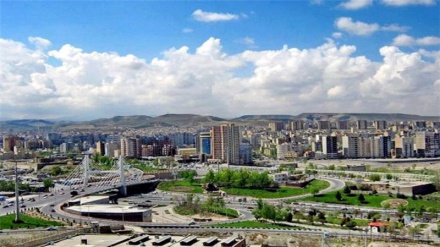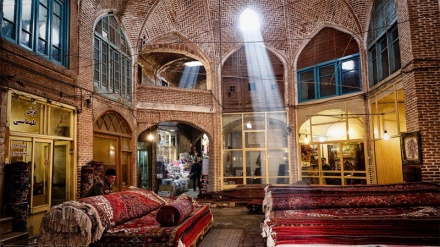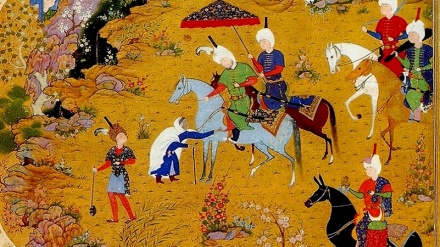Tabriz, 2018 (3)
Dear listeners, welcome to this week's episode of the series Tabriz, 2018. The city of Tabriz marks the intersection of history, nature, arts, and heroism of the people of Iran. Tabriz maintains a long history, and is home to scenic landscapes, capturing the attention of countless tourists. Today, we are familiarized with the natural, and scenic landscapes of this region of Iran.
East Azarbaijan Province accommodates natural touristic attraction sites, such as mountains, lakes, forests, valleys, ever-green plains, mineral water springs, caves, and falls, in addition to a number of historical and cultural sites; thereby maintaining a huge capacity for development of eco-tourism.
If you pass through the city of Tabriz, and are interested in seeing the scenic nature of this region of Iran, you maintain several available options and can observe the beautiful nature of this region, all year long.
Arasbaran is the name of a beautiful mountainous region in East Azarbaijan Province, which is a popular destination for tourists throughout the year. In order to travel to this forested region, a number of routes are available; with the most common route as traveling to Tabriz by air, and thereafter, driving from the city of Tabriz to the town of Ahar.
Arasbaran forested region covers an area of more than 70,000 hectares, which is likened to the forested regions, next to the coastlines of Caspian Sea and Black Sea.
Arasbaran forested region is situated on the southern banks of Aras River. This forested region is under the influence of the Mediterranean Climate, and given the high altitude of this forested region, a number of sub-climatic conditions exists in different parts of this region.
Arasbaran forested region is rich in flora and fauna species, while in fact this region is the venue of intersection of the three Mediterranean, Caspian, and Caucasian climates. The southern parts of this region are mainly covered with meadows, and travelers are witness to a forest in the northern corner of this region within 220-meter to 800-meter altitudes.
The mountains of this region maintain a high density and are referred to as Qareh-Daaq Mountains, which in Azari language refers to the multiplicity of these regional mountains.
Arasbaran is currently recognized as a national park, which is home to numerous animal species. It should be noted that given the intact scenic landscapes of this region, it was named as a conserved and protected region in the early years of the 1970s. the fact of the matter is that 22 bird species, 38 reptile species, 5 amphibian species, 48 mammal species, and 22 fish species live in this region. Among the mammals which live in this conserved region, one can refer to goats, boars, grizzly bears, and leopards, to name a few. Many birds, such as partridges, predatory birds, and water birds live in this region. One of the main missions of the Arasbaran National Park is to protect and revive one of the deer species, while seven deers were transferred from Golestan National Park to this region, a while ago.
In addition to fauna diversity in Arasbaran; this region is also home to a number of flora species, such as barberry, raspberry, and cranberry bushes, and pomegranate, apple, and pear trees. Out of the 2400 plant species which are found in Azarbaijan, nearly 1,400 plant species are found in Arasbaran forested region.
The locals, who live in the surroundings of Arasbaran forested region, are engaged in animal husbandry, horticulture, apiculture, handicrafts and tourism industries.
One of the touristic attractions of the city of Tabriz is the high-altitude pinnacles in the vicinity of this city, and the proclivity of mountaineers for traveling to this region. Sahand is the name of a pinnacle situated fifty kilometers south of the city of Tabriz, in East Azarbaijan Province. This pinnacle is located within Alborz Mountain Range, which is stretched from the west to the east. The ever-green foothills and springs of the Sahand Mountain are eye-catching. Sahand Pinnacle is mainly blanketed with snow, all year long. Its foothills are covered with colorful flowers throughout the year, luring many tourists, who travel to this region, to personally witness its stunning nature. This mountain has always been a seemly venue for the recreational activities of the residents of East and West Azarbaijan Provinces, and domestic and foreign tourists. Buttercups grow on the foothills of this mountain, shaping an astounding landscape for tourists, who travel to this region.
The presence of 185 local and migrant bird species, numerous mammals, and a variety of rare plant species and aquatics, has turned Sahand foothills and its marshlands into an important habitat for wildlife. Sahand Mountain has also led to the development of agriculture, animal husbandry, and apiculture in this region, and the ever-green nature of large swathes of East Azarbaijan Province and the city of Maraaqeh.
Presence of numerous springs on this pinnacle and its foothills has granted freshness and delicacy to this region, and has quenched the thirst of trees, orchards, and meadows.
Sahand Mountain is a highly appropriate location for the grazing of livestock of regional nomads; and the nomads of East and West Azarbaijan Provinces settle on the foothills of Sahand Mountain, every year, as their summer quarters. Given the presence of innumerable flowers on these foothills, this region is highly appropriate for apiculture and production of honey, and the honey produced in this region is well-known worldwide.
Chilly winters within Sahand Mountain has obstructed the growth of trees. However, a variety of flora species can be observed across this region.
Numerous mountaineers travel to Sahand Mountain in the spring season and early day of summer with the intention of ascending this mountain's pinnacle.
Those, who travel to the city of Tabriz can observe one of the other wonders of nature in the vicinity of this city. The colorful Aaladagh-Laar Mountains have been located en-route Mianeh-Zanjan Road and are one of the most astounding tourist attraction sites of Iran. Tourists can travel to these mountains, all year long. These mountains maintain a particular color due to sunrays, while in the autumn and winter seasons, they present a completely different picture due to snow- or rainfall.
MR/SS


